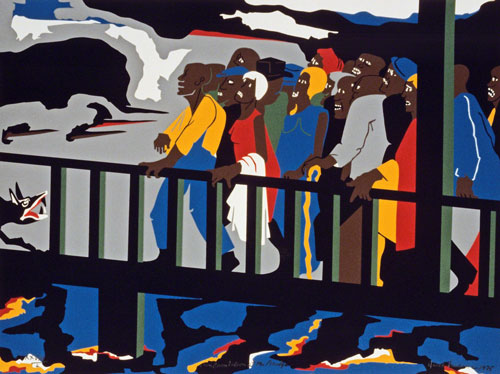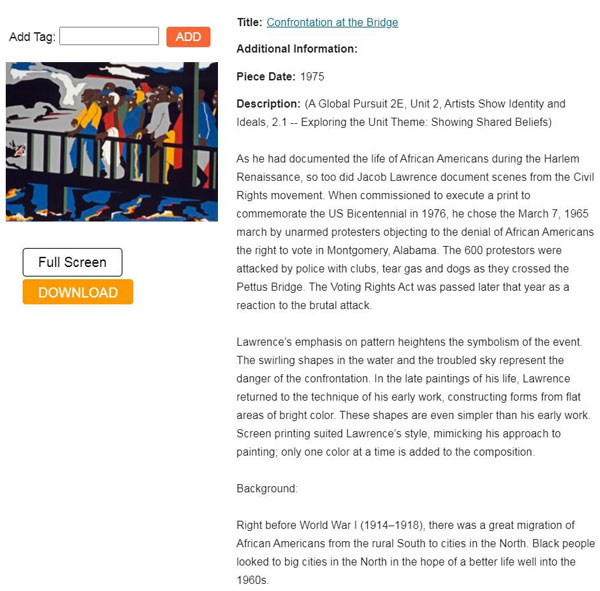Racial Justice through Art
We are at an important moment in our history, both in the United States and around the world. The killing of George Floyd has opened the eyes of people who realized viscerally—many for the first time—the profound meaning behind the Black Lives Matter movement. Many people are waking up to the very real danger and oppression that many people of color living in the United States and around the world have to face on a daily basis. Driving, shopping, jogging, playing in a public park, or going to a public swimming pool are all things that white people take for granted.

Jacob Lawrence (1918–2000 US) Confrontation at the Bridge, 1975, screenprint on paper, 49 x 66 cm (19-5/16" x 25-15/16"). The Cleveland Museum of Art, Anne Elizabeth Wilson Memorial Fund, © 2020 The Jacob and Gwendolyn Knight Lawrence Foundation / Artists Rights Society (ARS), New York (CL-946lwars)
Viral videos, such as the woman in Central Park who called the police on a Black birdwatcher requesting that he be charged, are helping many to see just how deeply ingrained white entitlement is in our society. And there is so much more to racism that is not so easily caught on camera. This could be the quality of care a black person receives in a hospital, or whether or not they are chosen for a bank loan, or a housing or job opportunity. Even our societal biases of who is and isn’t attractive, intelligent, hardworking, or trustworthy is an undercurrent.
As teachers, an important aspect of systemic racism lies in our expectations of students. Do we approach each student with the same high expectations? Does the way a particular student look or talk increase or diminish our expectations? Do we meet students’ parents and then base our expectations on those encounters? This is an area for ongoing self-examination and reflection.
We can further change our system by providing students with a safe space to explore deep, complex, and important issues. We can help students find their own lives reflected in artworks and use that as a springboard for honest, relevant discussions and we can provide windows for students to learn about the experiences of others. These two abilities—the ability to have one’s own experiences understood and validated, and the ability to learn about others’ experiences and perceptions—are critical components in helping students explore racial and social justice.
I believe that the art room (brick and mortar or virtual) is one of the best places to provide a safe and meaningful exploration of these issues. By introducing students to artworks from artists of different backgrounds and experiences, students learn about others and can get validation for their own experiences.
Let’s face it—most of us as adults have been in various types of training about equity, whether it focuses on sexual harassment, racial discrimination, multicultural sensitivities, etc. And sadly, I’d venture to say that while people can leave these trainings with some new insights, the direct teaching of these concepts doesn’t usually get at real insights and meaningful understandings that will change behavior, perceptions, and assumptions. It’s hard to change years of attitudes and assumptions through a prescribed “social justice” curriculum.
The notion of a course or class on racial equality and justice might sound like a solid way to try to address the current need, but we often don’t learn social and racial justice through classes, no matter how experienced the trainer or how well-crafted the curriculum. To begin, if we want to address systemic racism, we need systemic changes. Students need to see—through their curriculum and the school staff—people and ideas who represent their experiences, and they need to learn about other people’s experiences. We need to offer meaningful discussions that help each student explore these issues. We need to provide opportunities for our students to learn about the experiences of people who have been denied racial justice, or who are calling for racial justice. If an art curriculum focuses on “the masters,” it focuses on white men (with a few exceptions). So, an art curriculum that represents the diverse nature of our society is critical.
The art class is such an important venue for exploring at a deep, meaningful, and relevant level the issues our students of color experience, and perspectives that may be new to students about different cultures and experiences. Viewing and discussing artworks by a wide range of artists—male, female, nonbinary, queer, Black, Asian, Hispanic, Native American and so on—can create a real dialogue about what each artist has experienced in their life, and how a specific artwork or body of work expresses that.
Try to create deliberate, explicit opportunities for your students to see the world through other people’s eyes, and to see people like themselves who may have experienced some of the same challenges as they have.
At Davis Publications, we have several resources to help you find great, thought-provoking artworks to use as springboards for discussion. At our Art History blog, Curator’s Corner, you can read about:
- African American Art
- Hispanic and Latin American Art
- LGBTQI+ Artists
- First Nations Art
- Women Artists
- Asian Art
Each post not only provides examples of compelling artworks, but also provides background on the artists or cultures and the contexts that informed the art.
If you have a subscription to Davis Art Images (and you definitely should!), you and your students can search for images by time period or culture. Each image, like the example shown here of Jacob Lawrence, includes a wealth of metadata and information that can support your lessons. You can also search for 21st century art, which many students may find more relevant and timelier. Each subscription includes student access, so your students can conduct their own research, searching through our database of more than 20,000 images.

Whether you’re teaching texture, three-point perspective, or movement, you can complement each lesson with artworks that not only represent these art elements and principles, but that help students learn about others experiences and help all students share their own related experiences.
If you’re using a Davis textbook, you can be assured that each book has been carefully curated to represent a diverse range of artists.
Whatever art you’re using, begin by asking students to comment on what they see in the artwork that might connect to their own lives, or what they might learn from the artist that is not part of their daily experience. Extended, academically productive discussions can be significant, deep opportunities to truly explore racial justice with your students, to help students of color see themselves and their experiences validated, and to help all students learn about the perspectives of others.


Comments